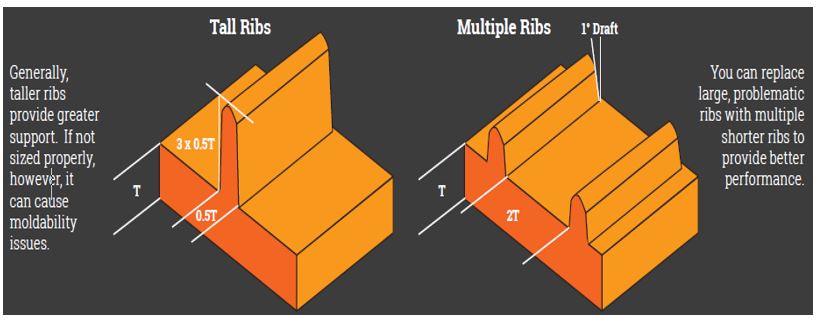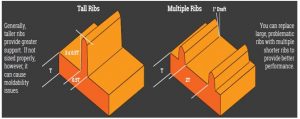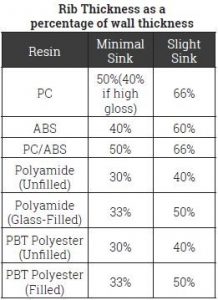
Designing Plastic Parts For Injection Molding? Ribs Can Help Add Support And Strength.
Ribs are a feature in plastic injection molded parts. They are thin extensions that run perpendicular from a wall or plane. They are commonly used to provide additional support and strength to a part.
Thickness and location are essential to rib design. Here are some helpful design guidelines:
- They should be designed with a thickness that is ½ the wall thickness to avoid a thick section at the wall base
- To minimize sink marks, design ribs that are approximately 60% of the joining wall thickness for minimum risk
- Best practices include spacing at a distance of at least twice the wall thickness
- Glossy materials require a thinner rib (40% of wall thickness)
Parts can be designed with tall or multiple ribs
Replace large, problematic ribs with multiple shorter ones to provide better performance. Taller ribs can also provide greater support however if they are not sized properly, they can cause moldability issues. (See Figure 1.)
Figure 1-Tall and Multiple Ribs

The material or materials being used for the part should also be considered when designing for resins. Depending upon the resin, rib thickness should be a percentage of the wall thickness. Refer to the chart below for some general resin allocations.

An advantage of using ribs is that they increase the strength of the part without increasing wall thickness. Walls that are too thick can sink, warp or result in other defects. Their integration into a part results in less material usage; therefore a more cost effective solution.
Working with an experienced injection molding manufacturer can not only lessen your risk with production issues but also save costs and time in the long run.
Working on a project?
Let us help you get that first prototype underway and have that part in your hands in as few as five days. Our engineers help you through the design process. Get your project started now!
